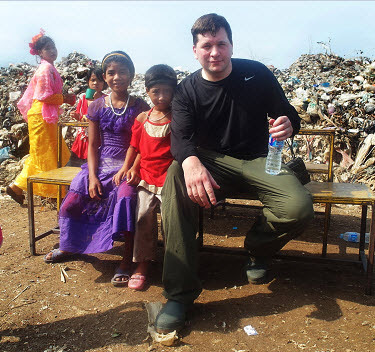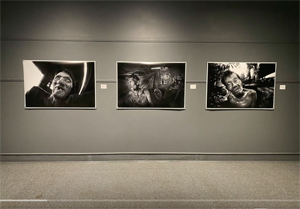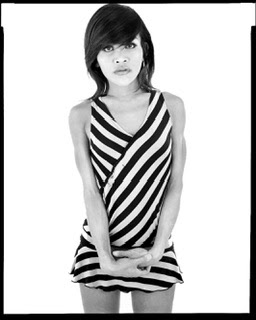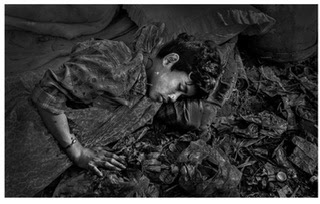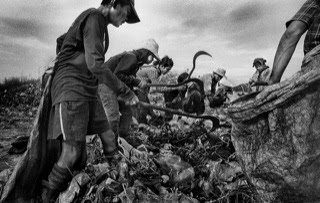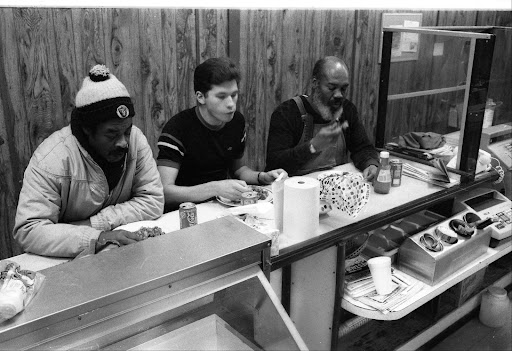Ronald Reagan, former governor of California, March 4 1976, by Richard Avedon. Photograph: © 2008 The Richard Avedon Foundation
Many of the photographic portraits that Richard Avedon took in the course of his long and celebrated career are bound up with the idea of fame. His subjects were frequently figures in public life, and being photographed by him served to reinforce their celebrity. Portraits of Power, the title of a new book published three years after Avedon's death to celebrate election year in America, presumably refers both to the power his subjects wielded and to the power Avedon's style of photography conferred upon them. For the most part this involved the subject being asked to stand against a white (or in some cases grey) backdrop, while the photographer, having prepared the plate in his 8"x10" camera, stood next to it, enjoying the freedom it gave him to talk to his subjects before pressing the shutter, encouraging them to relax and, as he admitted, sometimes gesturing, or taking a stance which they consciously or unconsciously imitated, thereby producing the picture he wanted.
Frank H Goodyear, associate curator of photography at the Smithsonian Institution, as part of his essay in the book, asked some of Avedon's subjects for their reactions to the experience of being photographed and to the results. What is quickly apparent is their realisation of how far he had preconceived the way they would look: "He knew what he wanted… He came in with a concept …" (John Kerry, US senator, Massachusetts), "He obviously knew what he wanted and he knew how to get it…" (Jerry Brown, former governor of California). "He must have had a picture in his mind…" (Dorothy Zellner, civil rights activist). Though most of them recognised some semblance of themselves, one or two felt they had been set up. Karl Rove, George W Bush's former chief strategist, complained: "The portrait is foolish, stupid, insulting. It makes me look like a complete idiot."
At several periods throughout Avedon's working life he turned his attention away from fashion and advertising towards politics, notably in the late 1960s, when he began a long project on America's counter-culture movement, photographing members of protest groups and left-wing activists. This included a famous multiple portrait of the Chicago Seven, accused of inciting riots at the 1968 Democratic Convention. The portrait is a triptych, a composite of three prints spliced together so that some of the figures overlap. It is reminiscent, as has often been said, of a police identity lineup.

The Chicago Seven: Lee Weiner, John Froines, Abbie Hoffman, Rennie Davis, Jerry Rubin, Tom Hayden, Dave Dellinger, Chicago, September 25, 1969, by Richard Avedon. Photograph: © 2008 The Richard Avedon Foundation In 1971, Avedon travelled to Vietnam where he made another composite portrait of the 11 members of the US Mission Council, an ironic companion &piece to the Chicago Seven. In 1976 he filled a special issue of Rolling Stone magazine with 69 portraits of members of America's "power elite". In the early 1990s he photographed the surviving members of the Kennedy court, and in 2004, another election year and the year of his death, he began a political project which he called Democracy, a cross-section of public figures and laymen who made up what he called, optimistically, "people-powered politics". For the first time he chose to make some of the pictures in colour. Among these, just two months before he died, was the keynote speaker at the Democratic national convention in Boston: the senator for Illinois, Barack Obama.
The writer Renata Adler, who collaborated with Avedon on the Rolling Stone portrait project, describes his overpowering desire to "make" the photograph he wanted. In most cases, she explains, the sitter's and the photographer's intentions were not radically different, but there were exceptions. Years before, when a conflict had arisen between the Duke and Duchess of Windsor as to how they wanted to look and how Avedon wanted them to be seen, Avedon told Adler he had "made up a sad story about dogs to get the dour expressions he was after".
He was interested in surface and surface detail, in evidence (the title of his 1994 Whitney Museum retrospective), in the marks that time and personal experience had left on a face, and in the ease or awkwardness with which a subject presented him or herself before the camera. He positioned them within a narrow designated area between the white backdrop and the lens (Ronald Reagan apparently required chalk marks to tell him where to stand), flashed a bright light in their faces and pressed the shutter. He wasn't concerned to find the "real" person, Adler writes. He wanted "to take a picture, a masterpiece. An Avedon."
What results in this book, which collects portraits from the early 1950s to his final work in 2004, is a sometimes relentless cavalcade of middle-aged and older men in suits (there are relatively few women) punctuated by hippies, yippies and representatives of late 1960s liberal politics who protested against the Vietnam war, racism, capitalism, and inequality. In large part, Avedon shared their concerns; to be attracted by fame and power did not mean that he admired or condoned the means of its acquisition. But afterwards he felt that the early project hadn't succeeded. "I photographed hundreds of people in the late '60s peace movement," he told Sally Quinn of the Washington Post in 1976, "and none of them stand up."
One of the characteristics of his pictures is that, though his subjects are required to stand calmly, hands to their sides, not smiling, they give off a kind of glamour, the same glamour that comes so effortlessly to his fashion pictures. As portraits they exude such confidence, such clarity; their subjects are stranded in a sea of white, with every pore, every wrinkle, every wart exposed. But they are portraits devoid of sympathy. Despite the attention to detail, gathered together they begin to acquire the role of specimens, pinned to the page by an energetic visual anthropologist, keen to add them to his collection.
Many of the subjects here are long past the height of their fame - names such as Kissinger, Ford, Kennedy, Bush Snr, George Wallace, Robert McNamara, Ronald Reagan - but their portraits still hold a horrible fascination. Not all the pictures are strong: some are weak, such as the one of Salman Rushdie; there are few happy portraits (Karl Rove is smiling, but inanely); there are eerie portraits and ones of people who are used to being photographed, such as Patti Smith or Sean Penn. And there is Barack Obama, a portrait of a man trying to look calm without giving away any clues at all.









